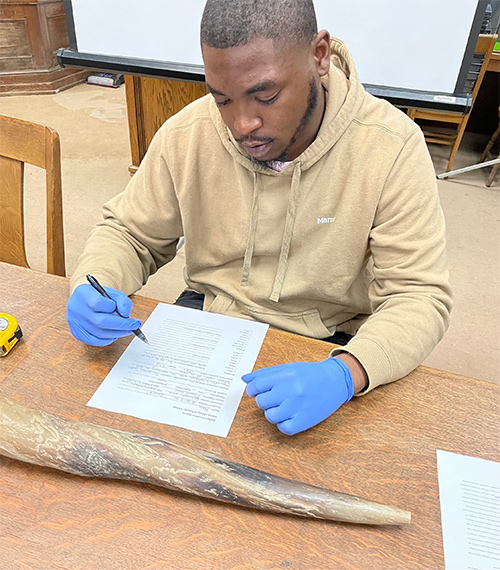

The installation of Talladega College’s historic Amistad Murals into The Dr. William R. Harvey Museum of Art in 2020 began an exciting new chapter in their history. A $199,632 financial award from the Institute of Museum and Library Services (IMLS) and a cost share from Talladega College promise to continue this history by forging new connections between the Museum and its audiences.
The IMLS Museum Grants for African American History and Culture (AAHC) program is designed to build the capacity of African American museums and support the growth and development of museum professionals at African American museums. At Talladega College, the public-private partnership will make possible a fresh, new interpretation of the stories told through the Amistad Murals and fund a significant three-year program of work to digitize a collection of historical African art and artifacts into an online, searchable database. Ultimately, the collection will be accessible to academics and researchers worldwide, and the Museum will enhance its role in increasing knowledge and awareness of African American history for audiences, educators, and students.
The collection of African art and artifacts was gifted to the College during the 1950s by Dr. Aaron M. McMillan (1895-1980), an African American medical missionary to Angola from 1931 to 1948. The artifacts represent an important connection between the College and the American Missionary Association (AMA), which was instrumental in its founding in 1867. An impressive number of Talladega College graduates entered the African mission field during the first half of the 20th century. As a result, the College's historical collections became a repository for materials concerning their missionary undertakings. These materials include personal papers, ephemera, cultural artifacts, African mission handcrafts, glass negatives, and photographs.
The grant project will involve the identification, conservation assessment, preservation, and digitization of the McMillan collection. Once complete, objects in the collection will be used in the ongoing presentation of the College’s historic murals on permanent exhibit in the Museum of Art. The murals were commissioned in 1938 for display in the newly constructed Savery Library. Artist Hale Woodruff, who had been invited to lecture at the College on the fine arts, was commissioned to paint three murals depicting the story of the Amistad. Another set of three murals depicting the founding of the College was commissioned a year later. Both topics reinforced the connection between the College and the AMA. The murals were displayed in the Library lobby until they were relocated to the Museum in 2020 after an extensive conservation process.
Additional activities funded by the grant will improve the storage conditions of the artifacts and improve access for students and faculty to engage with the objects in a research laboratory setting. Museum and library staff began working on the grant project this past spring when a conservationist from the Atlanta Art Conservation Center visited the collection to assess archival conditions. An independent curator will soon begin identifying objects in the collection to establish themes that support Alabama Course of Study (ACOS) standards, eventually making the collection more accessible to K-12 educators. The collection includes African tribal art and ritual artifacts, mission handicrafts, weapons, musical instruments, cooking utensils and vessels, and more. The material has been housed in the College’s Galangue Gallery in Savery Library since the 1970s, where it was only accessible by appointment.
About the Dr. William R. Harvey Museum of Art
In 1938, artist Hale Woodruff (1900-1980) was commissioned to paint a series of murals for Talladega College’s new Savery Library. Woodruff’s vibrant paintings captured key moments in African American history, including the uprising on the Amistad, the Underground Railroad, and the founding of Talladega College.
Today, these six murals are the centerpiece of the new Dr. William R. Harvey Museum of Art on the campus of Talladega College. In addition to the Murals, the Museum hosts temporary exhibits, cultural events, and educational programs. The Civil Rights Garden adjacent to the Museum celebrates noted 20th-century Civil Rights leaders.
The William R. Harvey Museum of Art is a not-for-profit 501(c)3 academic museum of Talladega College. The Museum is supported in part by funding from Talladega College. It receives additional support through public and private donations and grant programs. Donations are greatly appreciated and tax-deductible as allowed by law. For information, including legacy gifts, contact the Office of Institutional Advancement at (256) 761-6235.
Visiting the Museum
Admission is free; donations are appreciated. The Museum is open by appointment; all visits are guided. Schedule at least two weeks in advance by calling Savery Library at (256) 761-6284 or emailing tclibrary@talladega.edu. Allow at least one hour for your Museum visit. The Museum is wheelchair accessible. Motorcoach access and parking are available.
Mission Statement
The mission of the Dr. William R. Harvey Museum of Art is to support the goals of Talladega College by striving to inspire, enrich and impart knowledge to the Talladega College community and the general public through art.
About Talladega College
Talladega College, Alabama’s first private historically black liberal arts college, has been known for academic excellence for over 150 years. The College offers over 20 undergraduate and graduate degree programs. It has a strong tradition of bringing the world to Talladega via workshops, forums, and lectures by acclaimed artists, scientists, and political, business, and civic leaders. The historic campus is located in the city of Talladega in northeast Alabama.
About the IMLS
The IMLS is the primary source of federal support for the nation’s libraries and museums. IMLS supports and empowers America’s museums, libraries, and related organizations through grantmaking, research, and policy development. IMLS envisions a nation where individuals and communities have access to museums and libraries to learn from and be inspired by the trusted information, ideas, and stories they contain about our diverse natural and cultural heritage.